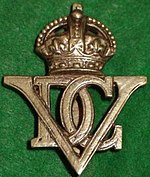5th Royal Inniskilling Dragoon Guards
| 5th Royal Inniskilling Dragoon Guards | |
|---|---|

Regimental Badge.
|
|
| Active | 1922–1993 |
| Country |
|
| Branch |
|
| Type | Armoured |
| Role | Cavalry |
| Size | Regiment |
| Part of | Royal Armoured Corps |
| Nickname(s) | "The Skins" |
| Motto(s) |
Vestigia nulla retrorsum (Latin: We do not retreat) |
| March | Quick: Fare Ye well Enniskillen Slow: The Soldier's Chorus from Gounod's Faust |
| Anniversaries |
Oates Sunday Balaklava Day Waterloo Day Salamanca Day |
The 5th Royal Inniskilling Dragoon Guards was a cavalry regiment of the British Army formed in 1922 by the amalgamation of the 5th Dragoon Guards (Princess Charlotte of Wales's) and the 6th (Inniskilling) Dragoons. It served in the Second World War and the Korean War. In August 1992, as a consequence of the Options for Change defence cuts, the regiment was amalgamated with the 4th/7th Royal Dragoon Guards to form the Royal Dragoon Guards.
The regiment was formed in 1922, as the 5th/6th Dragoons, at Cairo, Egypt by the amalgamation of the 5th Dragoon Guards (Princess Charlotte of Wales's) and the 6th (Inniskilling) Dragoons.
In 1923, the regiment was deployed to Risalpur, India. In 1927, the regiment discarded the "6th" and inserted Inniskilling into its title, thereby becoming the 5th Inniskilling Dragoon Guards. In the following year, the regiment moved to the UK for the first time, as the 5th Dragoon Guards. In 1935, it gained the Royal accolade to become the 5th Royal Inniskilling Dragoon Guards. In 1938, as part of the preparation for the Second World War, the regiment was mechanised; in the following year, it joined the newly formed Royal Armoured Corps (RAC).
On 3 September 1939, two days after the German Army had invaded Poland, the United Kingdom, France and their Allies declared war on Germany. Equipped with Vickers Mk.VI, the regiment acted as the reconnaissance regiment of the 4th Infantry Division of the British Expeditionary Force (BEF) that was deployed to the continent shortly after the war broke out. On 10 May 1940, the German Army launched their invasion of the Low Countries, thus ending what was known as the Phoney War. The German invasion was swift and successful; the Allied forces in Belgium, which included the regiment, having to retreat to the Scheldt River. Fierce fighting continued, the BEF continuing to withdraw further until the order was given for them to withdraw to Dunkirk in northern France. The regiment was successfully evacuated from Dunkirk in June 1940.
...
Wikipedia
